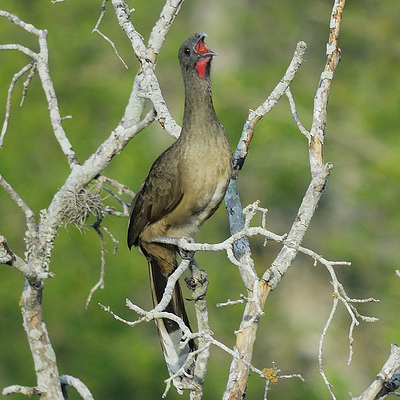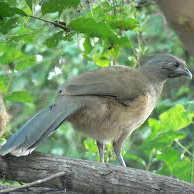
Plain chachalaca
(Ortalis wagleri)

Conservation status
Least concern
Scientific classification |
|
| Kingdom: | Animalia |
| Phylum: | Chordata |
| Class: | Aves |
| Order: | Galliformes |
| Family: | Cracidae |
| Genus: | Ortalis |
| Specie: | Ortalis wagleri |
Description

The plain chachalaca is a medium-sized galliform, around the size of a common pheasant. It measures 48–58 cm (19–23 in) in length, and varies in weight from 468–794 g (16.5–28.0 oz) for males and 439–707 g (15.5–24.9 oz)in females. Males are on average larger but because of overlap that isn't diagnostic of sex, and in appreance they are the same. It is long-necked with a small head and bare throat patch which becomes deep red in both sexes during the breeding season. Adults have a greyish head and neck with a dull olive-brown body and wings. The underbelly is pale to ochraceous and the tail is blackish with green gloss and buffy-white tip. The iris is brown and bill is black; orbital skin and the feet are dull grey.
The plain chachalaca is found from Texas, in the Lower Rio Grande, through the eastern coast of Mexico, the Yucatán Peninsula, Belize, northern Guatemala, northern Honduras and just into the north central part of Nicaragua, with a small population on the Nicoya Peninsula of northern Costa Rica. The species has also been introduced and established to San Patricio County in Texas and three islands, Sapelo, Blackbeard and Little St. Simons Island, on the coast of Georgia.
The plain chachalaca occupies a wide range of habitats, including primary forest, secondary forest, forest edge and riverine forest, thorny bush-scrub, and shrubland. It is also found in human modified habitats such as orchards, suburban parks and gardens and croplands.
Unlike other cracids, it is able to adapt to the scrubland that arises after the clearing of tropical rainforest. It can be found from sea-level to 1,850 m (6,070 ft).
The plain chachalaca is mostly diurnal and is most active in cool mornings and in the evening. It is mostly inactive during the heat of the day. Pairs or family groups roost communally in trees, usually on a branch, often touching, and facing the same way.
Zoológico de Vallarta A. C.
Leave your comments, your opinion is important to us

